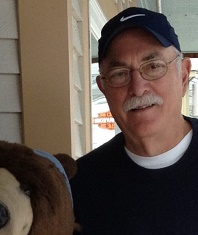
Thomas Richard Rumsey
Professor of Biological and Agricultural Engineering, Emeritus
Tom Rumsey was born and raised in Woodland, California. He earned his B.S. in Agricultural Engineering at UC Davis in 1965. He was a calm, gentle, friendly colleague. He could also perfectly throw an unhittable slow-pitch softball, as he demonstrated each year during informal post-barbecue games at the Department’s annual spring gathering of students, staff and faculty. Although the members of the Department have many fond memories of Tom, four of his characteristics stand out: love of mathematical modeling of complex systems, welcoming mentorship of students, dedication to teaching, and willingness to collaborate with faculty colleagues.
Early in Tom’s education and career, he developed a fascination with mathematics and numerical methods for solving complex equations describing real systems. His M.S. (awarded in 1966) research at UC Davis involved finite element modeling of the forced vibration of tree limbs, to help optimize vibratory harvesting of fruit. After graduation, Tom joined General Electric in San Jose, where he conducted computer simulations of a nuclear power plant. He then joined the U.S. Air Force and was stationed at the Missile Development Center, Holloman Air Force Base, New Mexico from 1968-1971. There he acquired and analyzed voluminous digital and analog data from flight tests of three advanced missile systems, receiving the Air Force Commendation Medal. He returned to UC Davis in 1972, where he conducted his doctoral research with Bob Fridley, again using numerical methods, in this case to analyze viscoelastic contact stresses in agricultural products such as fruit. He received his degree in 1974, then spent three years as a Research Mechanical Engineer with the USDA Agricultural Research Service in Berkeley prior to joining the UC Davis faculty in 1977.
Tom rapidly became known for his take-all-comers approach to working with graduate students – including his own as well as many others – to mathematically model and then solve equations for various systems. One of our faculty commented, “It can be argued that Tom has made more impact on our food engineering students than any other faculty member. They all take his courses and most have him on thesis and/or research committees. His mathematical modeling input to the students of other faculty is well recognized… .” Tom held weekly meetings with other faculty and their graduate students, to teach each other the mathematical techniques they found useful in their studies.
Tom was an excellent instructor. As one might expect, his teaching emphasized modeling, numerical methods and computer simulation. His undergraduate courses included Unit Operations in Food Engineering, and Dynamic Modeling of Processes in Biological Systems. He taught graduate courses on Modeling Biosystems, Analysis of Processing Operations: Drying and Evaporation, Solar Thermal Engineering, and Thermal Process Design.
Most of Tom’s research was aimed at solving real-world problems, therefore much of his work involved Cooperative Extension personnel, especially Jim Thompson. Tom and Jim investigated drying of walnuts, almonds and pistachios; dehydration; vacuum cooling; and heat transfer in storage of raisins. They also collaborated with Bob Curley and Blaine Hanson (on wind and photovoltaic energy for irrigation pumping), George Miller (rice drying) and Jerry Knutson (moisture loss during forced-air cooling; processing of pistachio samples). Tom collaborated with many food engineering colleagues – Paul Singh (drying of rice, cassava, yam and pistachio; heat and mass transfer in immersion frying), John Krochta (solar energy cooling and freezing; viscoelastic properties of edible lipids; properties of whey protein films), Kathryn McCarthy (dynamic simulation of double-effect evaporators), Mike McCarthy (control of tomato paste evaporators) and Paul Chen (aeration of rice in warehouses; mechanical properties of solid foods). He also worked with several other faculty in the Department, including Bryan Jenkins (control of humidity in greenhouses; simulating field drying of biomass), John Miles (tree response to vibration), John Dobie (solar collectors for heating air), Shrini Upadhyaya (a finite element model for coupled equations) and Ruihong Zhang (simulation of a two-stage anaerobic reactor), as well as Chemical Engineering Professor Ahmet Palazoglu (cross-flow rice dryers). Further demonstrating his diverse research interests, Tom developed models to predict microbial growth in commercial solid-state fermenters, and evaluated heat and moisture transfer models to improve the reliability of predictions of temperature profiles in tree bark during forest fires. Although Tom’s emphasis was on modeling, he validated the simulations using experimental or field data where possible.
The practical emphasis of Tom’s research is evident by the groups that funded much of his work, such as the California Walnut Marketing Board, California Pistachio Commission, and California Committee on the Relation of Energy to Agriculture. An equipment manufacturer stated, “Dr. Rumsey has done lots of good work on real world problems. In particular, his work on dryer modeling and dryer techniques are very good and informative. I have found him to be quite successful at transferring the academic and modeling information he has developed out into industry. Many of our customers have attended dryer training seminars held by him and have benefitted tremendously.”
Tom developed and conducted a number of half-day lab exercises related to food engineering, for the Engineering Summer Residency Program. This program was offered for several years to encourage high school students from underrepresented groups to pursue degrees in engineering. This voluntary effort was just one more example of Tom’s approach of placing the interests of others, especially students, above his own.
Bruce Hartsough
Kay Resler
James Rumsey
